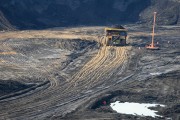The pressure is on — the international community has called us out on the serious environmental impacts of our oilsands, but instead of cleaning up the mess both industry and government are scrambling to spin the situation clean. Problem is, calling the oilsands clean won't make it so —and amidst increasing scrutiny the international community isn't going to fall for it.
Federal Environment Minister Jim Prentice recently rallied the Alberta government and the oilsands industry "to up our game, in terms of both environmental vigilance and in terms of our communication efforts."
Actually, on the surface his words don't sound too bad: "The oilsands must be developed in an environmentally responsible manner." He continues, and amps it up, "for those of you who doubt the Government of Canada lacks either the willingness or authority to protect our national interests as a 'clean energy superpower,' think again."
The trouble is, he doesn't back up his sentiments with actual plans and action — you know, something we could look to for proof that we are in fact, trying to become a "clean energy superpower."
Prentice isn't alone in thinking the problem with the oilsands is only one of image, nonetheless, he's wrong. I've studied the environmental impacts of oilsands development for the better part of a decade and made countless trips to the oil sands, and spinning the issue won't turn the tide of the increasingly informed and skeptical public — most Canadians now believe oilsands development has a net negative impact on Canada's reputation abroad.
Tony Hayward, CEO of British Petroleum (BP), has taken a page from Prentice's book. In an attempt to deflect shareholder concern about BP's proposed $10 billion inves tment in the oilsands, Hayward is endeavouring to differentiate intensive in situ oilsands drilling from the more environmentally destructive strip mining operations. He's calling in situ oilsands drilling "much more akin to conventional reservoir engineering... therefore the environmental footprint on the ground is no more or worse than normal oil or gas operation."
tment in the oilsands, Hayward is endeavouring to differentiate intensive in situ oilsands drilling from the more environmentally destructive strip mining operations. He's calling in situ oilsands drilling "much more akin to conventional reservoir engineering... therefore the environmental footprint on the ground is no more or worse than normal oil or gas operation."
He's just plain wrong. In situ oilsands drilling is nothing at all like conventional oil production. In fact, it's debatable whether it is, on balance, any better than oilsands mining.
Here's the proof in situ's no better than oilsands mining:
- Due to its enormous natural gas requirements, oil from oilsands drilling can produce three times more greenhouse gas pollution per barrel of oil, compared to oilsands mining and up to six times more polluting than conventional oil. This relative performance would worsen if in situ oilsands operators switch to dirtier fuels, as permitted under a draft government policy.
- When you consider the footprint on the landscape that results from meeting the greater natural gas requirements plus the direct impacts of in situ oil sands drilling, the total impacts on wildlife habitat are actually comparable to an oilsands mine.
- Fragmentation of the boreal forest by in situ oilsands wellpads, above-ground pipelines and processing facilities are destroying habitat for boreal birds and wildlife. For example, threatened woodland caribou risks extirpation from the oilsands region, leading a panel of industry, government and academics to note that, "Tough choices need to be made between the management imperative to recover boreal caribou and plans for ongoing bitumen development and industrial land-use."
- Cumulative impacts of the development of an astonishing 80,000 km2 of in situ leases (an area the size of Scotland which has been leased with no environmental assessment) will actually dwarf the impacts of oilsands mining.
And if in situ oilsands drilling operations are no better than mining (and on some counts worse), it's not credible to suggest that it is on par with the impacts of conventional oil production.
As we noted in Clearing the Air on Oilsands Myths — facts matter, the issues are complex and downplaying the risks and impacts is just plain irresponsible. Until decision-makers recognize that oilsands development has an "impact" problem rather than an "image" problem, Canada's tattered international image is bound to deteriorate even further.









